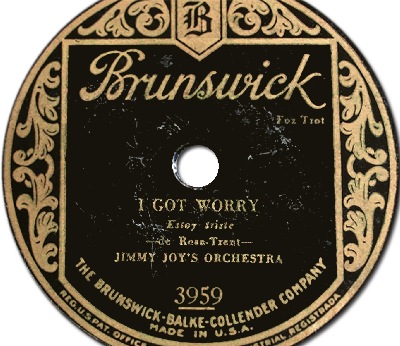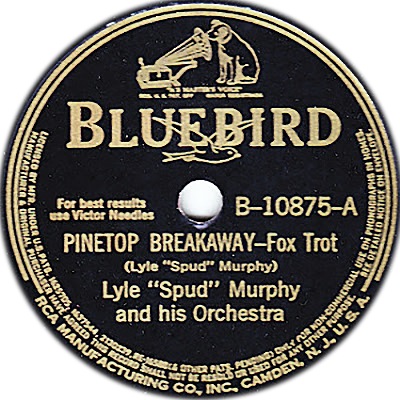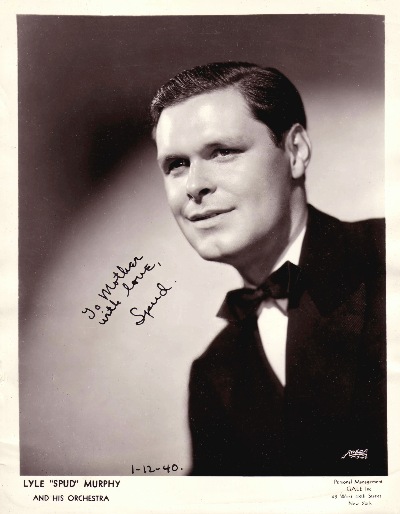
Lyle “Spud” Murphy: Unsung Hero of Swing
Arranger, composer and multi-instrumentalist Spud Murphy (Lyle Stephanovic,1908 –2005) wrote 600 charts for the top Swing orchestras and 100 songs during the 1930s, creating colorful and dynamic arrangements that shaped the sound of Swing.
Contributing mightily to the sound of the era, he conceived tuneful, multi-layered charts for Benny Goodman, Casa Loma Orchesdtra, Bunny Berigan, Fletcher Henderson and Bob Crosby.
In
the 1940’s and ‘50s he wrote for the movies, reinvented instruction for
composing and arranging and conducted innovative Third Stream recording
sessions. The terms ‘unappreciated
genius’ and ‘unsung hero’ do not overstate the significance of his impact on American
Popular music, largely forgotten today.
In a 2003 interview spoke with characteristic wit, modesty and
genuine pride for what he had achieved, vividly recalling famous bandleaders
and former associates. Added depth is provided by
rare historic recordings of Spud and fresh recordings of Murphy's music
from Mora's Modern Rhythmists, and commentary by Dean Mora, a protege of Murphy who has kept Spud’s music alive.
Introduction,
Get Happy
Read the complete article at the Syncopated Times:
Lyle "Spud" Murphy: Unsung Hero of Swing
Spud gradually achieved minor success working in regional bands like Jeff's Hot Rocks, the Rainbow Seven and writing arrangements for Johnny McFall’s Honey Boys, a 10-piece Texas band.
The first recording of a Murphy chart was by the Jimmy Joy Orchestra in Chicago 1928, the jaunty “I Got Worrry"
Pt. 1 Digging Spud Murphy
SPUD_MURPHY1A.mp3
GET HAPPY -- Benny Goodman Orch, 1936
GET HAPPY -- Mora's Modern Rhythmists, 2002
DIXIELAND SHUFFLE -- Mora’s Modern Rhythmists, 2002
I GOT WORRY -- Jimmy Joy Orch, 1928, 78 PRM
I GOT WORRY -- Mora's Modern Rhythmists, 2002
DAMES -- Mora's Modern Rhythmists, 2002
DAMES -- Joe Haymes Orch, 1934 78 PRM
MODERN MELODY -- Joe Haymes Orch 1933, 78 PRM
MODERN MELODY -- Mora's Modern Rhythmists, 2002
ANYTHING GOES -- Mora's Modern Rhythmists, 2002
THE GLORY OF LOVE -- Benny Goodman Orchestra, vocal Helen Ward, 1936
LIMEHOUSE BLUES -- Benny Goodman Orch, Let’s Dance broadcast, 1935
SPUD_MURPHY1B.mp3
ANYTHING GOES -- Rhythm Makers Orchestra [Benny Goodman] 1935, Radio Transcription
SHE’S A LATIN FROM MANHATTAN -- Benny Goodmand, voc. Helen Ward, Aircheck 1935
SHE’S A LATIN FROM MANHATTAN -- Mora's Modern Rhythmists, 2002
WHITE JAZZ (excerpt) -- Glen Gray Casa Loma Orchestra, 1931
MANIAC’S BALL (excerpt) -- Glen Gray Casa Loma Orchestra, 1931
THE OBJECT OF MY AFFECTION -- Casa Loma Orch, vocal Pee Wee Hunt, 1934
GOBLIN MARKET -- Mora's Modern Rhythmists, 2002
PINETOP BREAKAWAY -- Spud Murphy Orch 1939, 78 RPM
QUAKER CITY JAZZ -- Spud Murphy Orch, 1938, 78 RPM
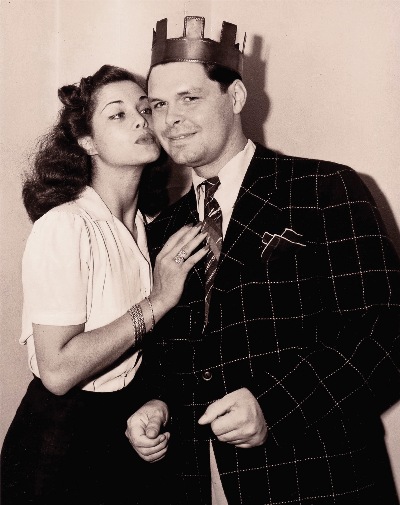
Spud with actress Carol Bruce in a 1940 LIFE Magazine article. The dubious award resulted from a poll among publishing houses’ secretaries declaring him the King of Tin Pan Alley.
Pt. 2 Digging Spud Murphy
SPUD_MURPHY 2A.mp3
BALLAD IN BLUE -- Benny Goodman Orchestra, 1935
DIGA DIGA DOO -- Benny Goodman Orchestra, Radio Aircheck, 1935
DIGA DIGA DOO -- Mora's Modern Rhythmists, 2002
DANCIN’ WITH A DEBUTANTE -- Spud Murphy Orch, 1938
DANCIN' WITH A DEBUTANTE -- Mora's Modern Rhythmists, 2002
DO YOU OR DON’T YOU LOVE ME -- Fletcher Henderson Orch 1936
SING, SING, SING -- Fletcher Henderson Orchestra, 1936
SING, SING, SING -- Mora’s Modern Rhythmists, vocal by Dean Mora, 2002
LETS FACE THE MUSIC AND DANCE -- Mora's Modern Rhythmists, 2002
JINGLE BELLS -- Benny Goodman Orchestra, 1935 Radio Transcription
JUST A PHRASE -- Spud Murphy Orchestra, 1938
DANCE OF THE DOINKS -- Spud Murphy Orchestra, 1939
SPUD_MURPHY 2B.mp3
BOOLY JA-JA -- Spud Murphy Orchestra, 1939
BIRD OF PARADISE -- Mora’s Modern Rhythmists, 2002
I KNOW THAT YOU KNOW -- Mora’s Modern Rhythmists, 2002
I KNOW THAT YOU KNOW -- Seeger Ellis Orchestra, 1937
SHIVERY STOMP -- Seeger Ellis Orchestra, 1937
SHIVERY STOMP -- Mora’s Modern Rhythmists, 2002
NO OTHER ONE -- Benny Goodman Orch, vocal Helen Ward, 1935
HOLD OUT FOR LOVE -- Spud Murphy Orchestra, 1939
BALLAD IN BLUE -- Mora's Modern Rhythmists, 2002
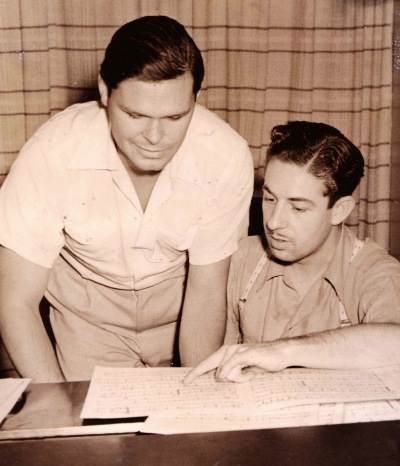
I asked Murphy what made him a successful Swing arranger. His main answer was that if the melody of a tune was good he’d use it. If it wasn’t would use very little and make up the rest – though I suspect there’s a great deal more to it than that. Marked by his signature talent for innovation and invention, he wrote some 600 arrangements by his own estimate, and more than 100 original tunes during the 1930s. Spud was skilled at generating colorful, deeply layered charts that were custom designed to display an ensemble’s strengths. He often had the advantage of writing for guys he knew intimately from years on the road, telling me “I write for the players, I don’t write for the instrument . . . it doesn’t say first alto saxophone or third trumpet or anything, it’s the guy’s name.”
<BR><I> </I>Goodman, Anything Goes, Latin from Manhattan
In his landmark book, Lost Chords: White Musicians and Their Contribution to Jazz, 1915-45, Richard Sudhalter calls him “one of the great neglected heroes of early jazz arranging” who “never achieved the critical attention accorded [Gene] Gifford or Fletcher Henderson.” Murphy’s scores “helped shape the sound and style of Benny Goodman’s Orchestra even before the leader began buying arrangements from Henderson.”
Poignantly, those remarks are buried in the footnotes of Sudhalter’s 900-page tome, inadvertently highlighting Murphy’s unwarranted and confounding obscurity.
By the late 1930s Spud was a well-known and highly respected band arranger. He moved to the Los Angeles area, and in 1937 his Spud Murphy’s Swing Arranging Method was first published. In the '40s and the '50s he went on to compose for more than 50 motion pictures, jazz albums, and occasionally for Benny Goodman and others. He briefly led his own small “third stream” combo in the mid-1950s.
Arranging for Goodman
Overlapping
with his work for Casa Loma, Spud was a staff arranger for Benny Goodman and his Orchestra from 1935 to ‘37. The effervescent “Get
Happy” is probably Murphy’s best-known chart for Benny. Also among his 102 arrangements for the
orchestra are the tasteful classics, “Ballad in Blue” and “Diga Diga Doo.”
Goodman, Ballad in Blue, Cab Calloway, Diga Diga Doo
Working
for Benny:
Well it had both a high and a low in
it. The high: it was probably the best
band around. And the low was
Goodman. I don’t want to belittle him
because it was not that way. He was just
strange . . . he never remembered
anybody’s name, so he called everyone “Pops” including his own family because
he couldn’t remember their names either.
Goodman would . . . have dinner and listen
to [Casa Loma] at the Essex House to see if I was giving them the same
arrangements that I’d made for Goodman.
Which is silly, the combinations were entirely different.
The program that we were on, the Let’s
Dance show was on Saturday I guess, and they rehearsed on Friday. I had to do four arrangements a week for him:
Monday, Tuesday, Wednesday, Thursday.
But I also had to do two arrangements for
Glen Gray and the Casa Loma band. So, I
had to do both of them on Friday. And
the reason I could do that is because [Casa Loma] rehearsed after their job at
1:30 in the morning. So that kept me
busy.
Casa
Loma and Gene Gifford v. Goodman
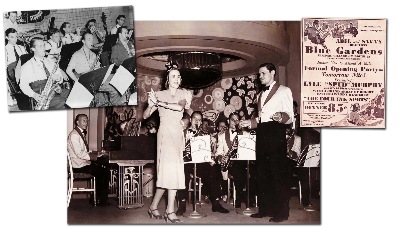
Spud’s band is seen recording and performing in late 1939 or early 1940 in New York City. Perhaps the unidentified singer was a ‘Latin from Manhattan.’
Spud’s Orchestra, 1938 -
early 1940s
Murphy
had modest success leading an ensemble of his own. In New York, Spud Murphy and his Orchestra held steady residencies and cut good
records. He seems to have maintained an
evolving ensemble as he made a transition to Southern California in the early
1940s.
Composing, arranging and
sometimes playing clarinet or sax, he waxed fourteen tunes for Decca, Vocalion
and Bluebird labels 1938-39, including several originals ranging from
mainstream Swing to the Raymond Scott-like “Booly Ja-Ja.
<BR>
Spud
Murphy Orchestra, Just a Phrase, Booly Ja-Ja, Quaker City Jazz
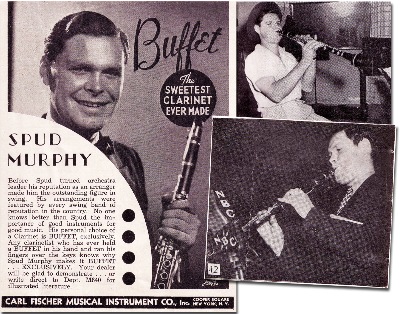
Accomplished Instrumentalist
By the late 1930s, Murphy was a respected arranger, his fluency on several instruments aiding his writing. Plus, he had a second-career as a skilled multi-instrumentalist playing clarinet, most of the saxophone family, trumpet, flute, oboe, and bassoon.
Clarinet gradually became Spud’s bread and butter instrument and he was a popular soloist. He said that he preferred the smaller, lighter instrument because it didn’t require the paraphernalia of a saxophone: straps, instrument-stands, carrying cases, or ofttimes, multiple instruments and part-books.
Dynamic
Composer and Honored Elder
In
the early 1940s, Murphy continued advancing his skills, moved to Los Angeles
and authored Spud Murphy’s Swing Arranging Method. He became a staff composer and arranger at
Columbia Pictures during the 1940s and ‘50s, scoring more than fifty motion
pictures.
His theme music for The Three
Stooges, derived from “Three Blind Mice,” was one of his most famous movie cues. During the 1950s he still occasionally wrote
for Benny Goodman or other bandleaders.
He served as President of the American Society of Arrangers (1965-77) and
was honored into his ninth decade.
Murphy
led a series of notable jazz ensemble recording sessions at the famed Capitol
Studios in Hollywood, 1954-57. The
all-star roster featured saxophonists Frank Morgan, Bobby Gordon and Buddy
Collette with Andre Previn (piano), Curtis Counce (bass) and drummers Chico
Hamilton or Shelly Manne.
Spud composed,
arranged, directed and played celeste (keyboard), creating innovative music for
record albums released variously as New
Orbits in Sound, Gone with the
Woodwinds and Four Saxophones in
Twelve Tones.
<I><BR></I>New
Orbits in Sound
Pinetop Breakaway, Spud Murphy and his Orchestra
Sage Educator
Murphy
eventually authored 26 books including an extended course on composing,
arranging and orchestration, his Equal Interval System.
Kennard Ramsey, a film and television
composer who studied with Mr. Murphy said that it ''took a lot of the mystery and misinformation out of traditional music
studies -- he made it so simple to see."
Illustrious graduates of the method include Oscar Peterson, Herbie
Hancock and Quincy Jones.
Equal
Interval System
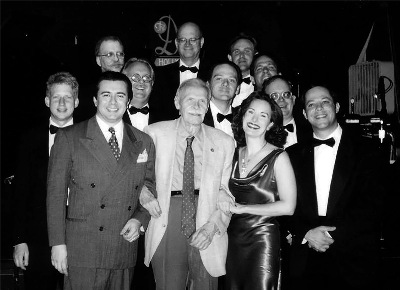
In his ninth decade Spud continued to be honored as a composer and music educator who published more than 26 books, including his own extensive course on composing, arranging and orchestration known as the Equal Interval System. Students of this method have included Oscar Peterson, Bennie Green, Herbie Hancock and Quincy Jones.
It was a great privilege for me to interview Lyle “Spud” Murphy about his amazing eight decades or so of making music. I was especially eager for him to talk about some of the truly great musicians he’d worked or partied with, and he didn’t disappoint. He told great stories about Fats Waller, Cab Calloway, Glen Gray, Clarence Hutchenrider (of Casa Loma fame) and Benny Goodman.
<BR> Seeger Ellis Choirs of Brass, I Know that You Know, Shivery Stomp
An
Unsung Genius
A
polymathic musician and tune smith, the fertile mind of Lyle “Spud” Murphy
seized upon any venue, medium or format as an opportunity for application of
his sparkling gift for musical organization and invention. His practical teaching system brought instruction
for composing and orchestrating into the modern era.
Our hero was in the vanguard of Swing, first
among equals in a coterie of mostly forgotten scribes and unheralded architects
who laid the foundations of Jazz, Swing and Popular American music during the middle
years of the Twentieth Century.
‘Doing
What I Liked to Do:’
"Well, I would have done this anyway, money
or no money. I’m very fortunate in the
fact that I made a living doing what I liked to do. And not everybody gets that opportunity."
Conclusion,
Ballad in Blue
Thanks, and Sources:
Spud
Murphy was interviewed in Los Angeles, 2003.
Great thanks to Dean Mora who assisted with the
interview and generously supplied photos, background data, rare audio and
commentary.
Mora’s Modern Rhythmists offer
Murphy’s arrangements on the CD Goblin
Market (currently out-of-print).
Thanks
to Dan Radlauer for expert commentary and technical assistance.
Lyle
“Spud” Murphy: Arranged Theme for Three Stooges, John Thurber, Los Angeles
Times/Boston.com, 8.14.2005
Equal
Interval System
Murphy’s
scores and arrangements are found at the Tulane Jazz archives and in the Benny
Goodman collection at Yale University.
Jazz
Records: 1897-1942 [discography], Brian Rust (Arlington House,
1978)
Read the complete article at the Syncopated Times:
Lyle Spud Murphy: Unsung Hero of Swing
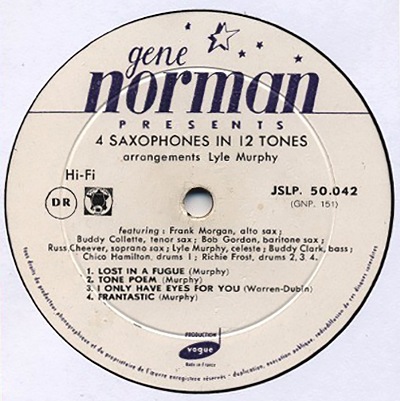
Tip Jar
This site is free. But you can help sustain it, and encourage me with donation to the tip jar. Secure payment through PayPal is anonymous, except that I will see your e-mail address.
Donation $5.00
Donation $10.00
Donation $20.00
Donation $35.00
Donation $50.00
Donation: You decide

